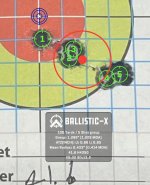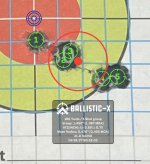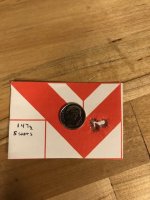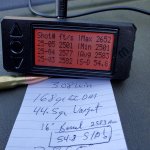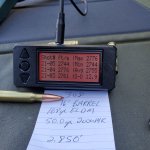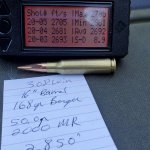Hi Everyone
Today I managed to go to the range and do some testing.
Rifle is a Defiance Ruckus with 24” CF proof Barrel with 1:7.5 twist.
Here is my sizing process:
-Peterson 2 times fired LRP
-FL sized with SAC sizing die
-Ran through mandrel for 2k neck tension.
Trimmed to 2.009
C.B.T.O= 2.166 (0.020 off the jam)
C.O.A.L= 2.878
Primer: CCI BR2
Powder: H4350
Chronograph: LabRadar
All the brasses had the same exact shoulder size. Powder charges triple checked before seating and settled by tapping on the bench lol.
Here is the results:
40.8g
SD:4.71 ES:9.88 2695fps
41.0gr
SD: 9.11 ES:18.35 2714fps

41.2gr
SD: 10.45 ES: 22.25 2726fps

41.3gr
SD: 14.13 ES: 29.80 2748fps

41.4gr
SD: 13.06 ES: 27.97 2743fps

41.5gr
SD: 4.10 ES: 10.95 2761fps

41.6
SD: 13.2 ES: 32 2762fps

41.8
SD: 18.33 ES: 38.37 2785fps

I started having a little bit of heavy bolt lift at 41.4gr
I see two flat spots around 41.3-41.4 and 41.5-41.6
I like the ES/SD of 41.5 but here is the issue, at this point if I seat the bullet deeper it will cause more pressure and if I higher to reduce the pressure I am only 10 thou of the jam which is very close considering future adjustments I don’t want to go over AICS Mag length.
Any suggestions to choose the right node would be appreciated.
Today I managed to go to the range and do some testing.
Rifle is a Defiance Ruckus with 24” CF proof Barrel with 1:7.5 twist.
Here is my sizing process:
-Peterson 2 times fired LRP
-FL sized with SAC sizing die
-Ran through mandrel for 2k neck tension.
Trimmed to 2.009
C.B.T.O= 2.166 (0.020 off the jam)
C.O.A.L= 2.878
Primer: CCI BR2
Powder: H4350
Chronograph: LabRadar
All the brasses had the same exact shoulder size. Powder charges triple checked before seating and settled by tapping on the bench lol.
Here is the results:
40.8g
SD:4.71 ES:9.88 2695fps
41.0gr
SD: 9.11 ES:18.35 2714fps
41.2gr
SD: 10.45 ES: 22.25 2726fps
41.3gr
SD: 14.13 ES: 29.80 2748fps
41.4gr
SD: 13.06 ES: 27.97 2743fps
41.5gr
SD: 4.10 ES: 10.95 2761fps
41.6
SD: 13.2 ES: 32 2762fps
41.8
SD: 18.33 ES: 38.37 2785fps
I started having a little bit of heavy bolt lift at 41.4gr
I see two flat spots around 41.3-41.4 and 41.5-41.6
I like the ES/SD of 41.5 but here is the issue, at this point if I seat the bullet deeper it will cause more pressure and if I higher to reduce the pressure I am only 10 thou of the jam which is very close considering future adjustments I don’t want to go over AICS Mag length.
Any suggestions to choose the right node would be appreciated.
Attachments
Last edited:

